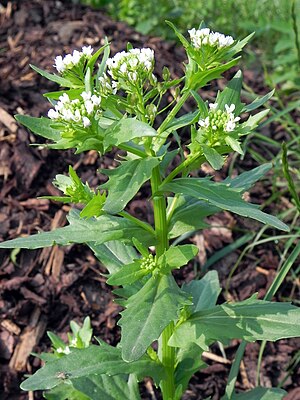Acker-Hellerkraut
| Acker-Hellerkraut | ||||||||||||
|---|---|---|---|---|---|---|---|---|---|---|---|---|

Acker-Hellerkraut ( Thlaspi arvense ) |
||||||||||||
| Systematics | ||||||||||||
|
||||||||||||
| Scientific name | ||||||||||||
| Thlaspi arvense | ||||||||||||
| L. |
The Acker-Hellerkraut ( Thlaspi arvense ), also known as Acker-Paschelkraut , Acker-Pfennigkraut or Ackertäschel , is a common member of the cruciferous family (Brassicaceae) in Central Europe .
description
The usually annual herbaceous plant reaches a height of about 10 to 40 cm. The whole plant is bare, yellow-green and smells clearly of garlic when rubbed . The stem grows upright, is usually branched and angular. All leaves with the exception of the lowest are sessile and arrow-shaped, encompassing the stem. They are elongated to narrow obovate, entire or toothed. The grape is profuse. The sepals are elliptical in shape and about 2 to 2.5 mm long. The petals are white, elongated wedge-shaped, rounded to weakly edged and about 3 to 5 mm long. The pods sit on about 7 to 15 mm long and almost horizontally protruding stems. They are almost circular, 12 to 18 mm long and have broad wings all around. They are strongly flattened and have a deep, very narrow incision at the top. The stylus is only 0.3 to 0.5 mm long. The pod contains 4 to 7 dark brown, curved, grooved, ellipsoidal seeds per seed compartment.
The Acker-Hellerkraut flowers mainly from April to June, occasionally until September.
The species has chromosome number 2n = 14.
ecology
The Acker-Hellerkraut is an annual , summer or winter annual plant that has roots up to 50 cm deep and is perhaps therefore relatively insensitive to herbicides . When rubbed, the leaves give off a slight smell of leek .
The flowers are homogamous to female " nectar- carrying disc flowers". The insect visit is sparse. Mostly spontaneous self-pollination occurs . It is typical that new flowers are planted on the long grapes above, while the first fruits are already ripe below . The bloom time is mainly from April to June, occasionally also until September.
The broadly lined, rounded pods serve as a vestibule. The diaspores spread as a wind and animal spreader and as a rain ballist. Human expansion occurs when seeds are treaded with soil and when they are carried away with harvesting equipment. The seeds are rich in fatty oil and can germinate for over 30 years. Fruit ripening is from May to November.
Occurrence
Location requirements
The Acker-Hellerkraut grows in arable weed communities, but also in ruderal fields and on rubble sites. It prefers nutrient-rich, humus-rich, especially loamy soils. It is a character species of the Fumario-Euphorbion association in Central Europe , although it occurs less frequently in societies of the Sisymbrion association or the Secalietea class.
distribution
Thlaspi arvense is distributed practically throughout Europe and from West Asia to East Asia and on the Indian subcontinent. As a neophyte it is also found in North America, South America, Africa, Australia and New Zealand. The species is widespread and common in Germany, Austria and Switzerland. In the Allgäu Alps, it rises in Kleinwalsertal near the mountain station of the Kanzelwandbahn up to 1940 m above sea level.
Others
The name "Hellerkraut" or "Pfennigkraut" is derived from the rounded pods that are reminiscent of small coins.
use
Acker-Hellerkraut can be cooked or eaten raw. It has a bitter taste that can be softened by steaming.
literature
- Henning Haeupler , Thomas Muer: picture atlas of the fern and flowering plants of Germany (= the fern and flowering plants of Germany. Volume 2). Published by the Federal Agency for Nature Conservation. Ulmer, Stuttgart 2000, ISBN 3-8001-3364-4 .
- Wolfgang Adler, Karl Oswald, Raimund Fischer: Excursion flora of Austria. Ed .: Manfred A. Fischer . Ulmer, Stuttgart / Vienna 1994, ISBN 3-8001-3461-6 .
- August Binz , Christian Heitz: School and excursion flora for Switzerland . Schwabe & Co. AG, Basel 1986, ISBN 3-7965-0832-4 .
- Erich Oberdorfer : Plant-sociological excursion flora . Ulmer Verlag, Stuttgart 1990, ISBN 3-8001-3454-3 .
- Christian August Friedrich Garcke : Illustrated flora . Paul Parey Verlag, 1972, ISBN 3-489-68034-0 .
- Ruprecht Düll , Herfried Kutzelnigg : Pocket dictionary of plants in Germany and neighboring countries. The most common Central European species in portrait. 7th, corrected and enlarged edition. Quelle & Meyer, Wiebelsheim 2011, ISBN 978-3-494-01424-1 .
Individual evidence
- ↑ a b c Erich Oberdorfer : Plant-sociological excursion flora for Germany and neighboring areas . 8th edition. Page 448. Stuttgart, Verlag Eugen Ulmer, 2001. ISBN 3-8001-3131-5 .
- ↑ a b Thlaspi in the Germplasm Resources Information Network (GRIN), USDA , ARS , National Genetic Resources Program. National Germplasm Resources Laboratory, Beltsville, Maryland. Retrieved July 31, 2017.
- ↑ Erhard Dörr, Wolfgang Lippert : Flora of the Allgäu and its surroundings. Volume 1, IHW, Eching 2001, ISBN 3-930167-50-6 , p. 614.
Web links
- Acker-Hellerkraut. In: FloraWeb.de.
- Distribution map for Germany. In: Floraweb .
- Thlaspi arvense L. In: Info Flora , the national data and information center for Swiss flora . Retrieved October 26, 2015.
- Distribution in the northern hemisphere
- Thomas Meyer: Data sheet with identification key and photos at Flora-de: Flora von Deutschland (old name of the website: Flowers in Swabia )


